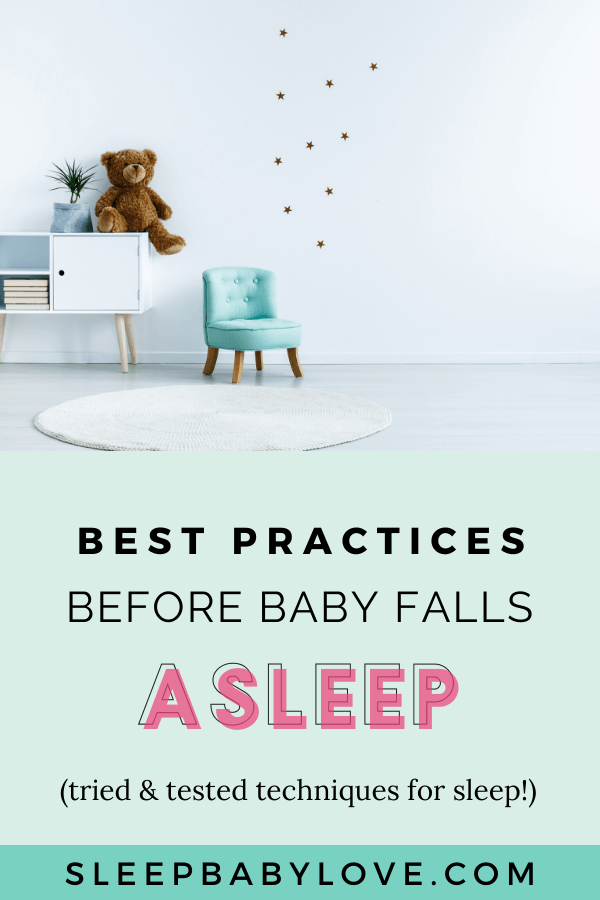Best Practices Before Your Baby Falls Asleep
Sleep training your baby is a feat in itself, but necessary nonetheless. For children, learning how to sleep and fend for themselves in their dark bedrooms is an essential survival skill; not to mention imperative for you and your baby’s continued good health.
In fact, a regular bedtime routine has been proven to help babies sleep easier, better, and wake up less often in the night, according to a study of 405 mothers.
So, I’ve collected a few tried and tested techniques that you can use to jumpstart your baby’s sleep habits from birth to help them sleep through the night, every night.
1. The 5 S’s
When you have a newborn, you will be willing to do anything to calm your sweet little baby – especially when she won’t calm otherwise. Well here are some tips to keep your sanity.
Developed by renowned baby specialist Dr. Harvey Karp, this 5-part routine is based on the principle that babies are at their calmest in an environment that best mimics the womb’s soothing sensations:
- Swaddling: Give your baby the illusion of a snug womb by wrapping them in a blanket up to their shoulders. However, while excellent for sleep-readying newborns, swaddling infants that are prone to rolling over on their tummies while sleeping can increase the risk of SIDS (Sudden Infant Death Syndrome).
- Stomach Position: Following a firm swaddle, settle your baby face-down and on their tummy while gently rubbing their back for an instant soothing effect. This is also highly effective for older infants and toddlers who have outgrown swaddling.
- Shush: As opposed to complete silence, newborns are more used to the loud sound of blood flowing within the womb. Mimicking the sound by gently shushing as you rub their back can help lull your baby to sleep.
- Swing: Recreate the constant in-womb movement by holding your baby on their back, to the side, or on their stomach while gently swinging yourself sideways from the waist.
- Suck: Consider giving your baby a pacifier to suck until they fall asleep. Not only is it an effective self-soothing technique, but it also helps prevent SIDS by clearing up your baby’s airways. However, avoid hanging the pacifier around their neck to prevent choking, and wait until your baby is 3-4 weeks old or is used to breastfeeding.
2. Eliminate the Blues
The blue spectrum in white light, whether natural or artificial, signals the brain to delay drowsiness and sleepiness by suppressing the hormone melatonin. Eliminate that, and you can ensure a good night’s sleep for you and your baby.
Simply install a low watt amber or orange bulb to simulate a calming sleep environment in the room, while also facilitating nighttime feeding sessions and diaper changes.
3. Rules of Nighttime Feeding
Nighttime feedings are inevitable for even the calmest of babies, with most mothers complaining of an active, wide-awake baby post-feeding. Avoid this common dilemma by feeding your baby shortly before bedtime to decrease the number of nightly disruptions. Keep it brief and avoid eye contact with your baby during feeding.
This will send the signal that playtime is over, thus helping them fall asleep faster after they have been fed, burped, and put back to bed. Make sure that the room is dark or minimally lit and quiet during nighttime feedings.
4. Avoid Complete Silence
As I’ve said before, newborns are more used to the loudness and mayhem of the womb. So, forbidding sound as bedtime approaches only make the surroundings unfamiliar for your baby, and leaves them incapable of falling asleep in different environments as they grow older.
“Keep a normal noise and activity level around your baby to accustom them to bedtime and eliminate future stress.” – words by Mrs. Melisa Corbin, Health and Psychology Expert at Academist Help.
Right before sleep, turn on your white noise machine on – like these – to mimic a nice steady sound like your baby heard in the womb.
5. Temperature Control
Instead of wrapping your baby in multiple layers before bed and risking overheating and SIDS, dress your baby in light pajamas and only one thin wrap or blanket. Experts also recommend keeping the room close to 70 degrees to avoid the risk of both overheating and catching a cold.
6. Go Ferber
Once your baby is older than 4 months, you might be ready to break sleep associations (things standing in the way of your baby falling asleep on her own).
You can try sleep training your baby by adopting the tried and tested Ferber Method. This helps teach your infant to sleep on their own and put themselves back to sleep when they wake up at night. This method may be complicated for the first few nights, but most parents see a notable improvement in their baby’s sleep span after the 3rd or 4th night. So, if you have a 5-6 month or older infant, here’s what you can do:
- When your baby becomes drowsy, put them in their crib, say goodnight, soothe and leave the room.
- If they cry, wait for 1-5 minutes, depending upon you and your baby’s nature-before checking upon them.
- Try to console them upon re-entering without picking them up. Do not stay longer than 2-3 minutes, even if they continue crying when you leave.
- Gradually increase the waiting time by 2-3 minutes for going to check up on them after the first time. Continue to increase the initial waiting time by 5 minutes every night after that.
The Ferber Method may not be suitable if you find it too challenging to stay away from your baby when they cry. Don’t think that one method is better than the other.
It’s the consistency of teaching your baby independent skills that’s the most important and making sure you and your baby is ready.
7. Try Fading
A softer alternative to the Ferber Method, fading is a highly effective self-soothing technique that you can start teaching your infant at as early as four months.
- Start by standing very close to your baby’s crib while soothing them only with your voice without picking them up on the first night.
- Keep moving farther away from the crib every night, hence letting your baby recognize the pattern and helping them soothe themselves to sleep.
- As the training continues, your baby will take less time to fall asleep than the night before, eventually falling asleep without your help.
8. Plan Your Activities
For infants and toddlers, certain activities can help establish a sense of routine, and can also be used to make bedtime less scary for them. Try playing active games like peek-a-boo with them during the day, and quieter games at night, while saving your baby’s favorite activity for last and in the bedroom.
You can also try bathing them before bedtime if your baby enjoys it. Whatever activities you choose, make sure to follow the same order every night to familiarize your baby with bedtime.
9. Stick to Your Routine
From a report written by Crowd Writer for one of their students,
“No technique or exercise can help effectively sleep train your baby if you don’t establish a routine and stick to it. Your baby will only learn to sleep correctly and by themselves if they learn to adapt to that routine, as it encourages self-soothing and familiarizes them with bedtime. Even one night of changes can unwind your hard work, so make sure to follow your baby’s bedtime routine every night as it is.”
It may feel exhausting now, but it won’t last forever, because the amount of sleep time your baby needs and their sleeping routine will change with age. Establishing a good bedtime routine will go a long way in helping your child become a healthy sleeper at night. So keep calm and carry on!
Author Bio:
Stella Lincoln is a Health Expert and currently associated with King Essay. She also conducts several seminars at UCLA regarding health and psychology. Stella owns a blog Educator House, where she shares her knowledge.


